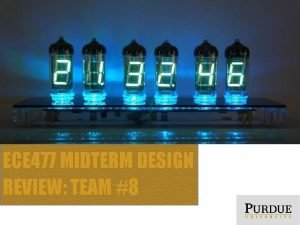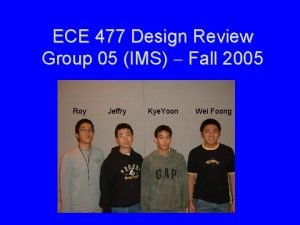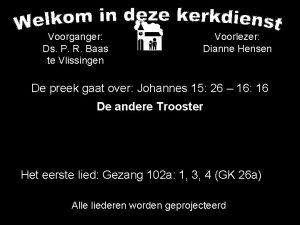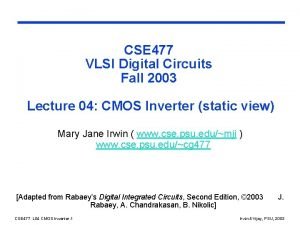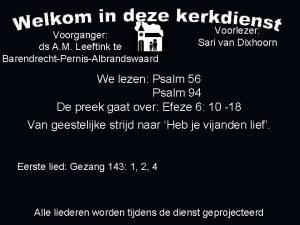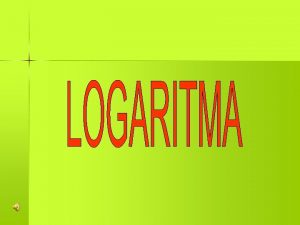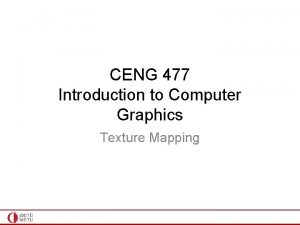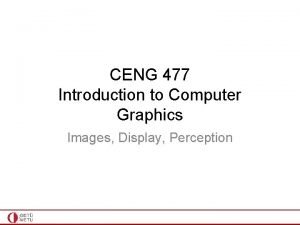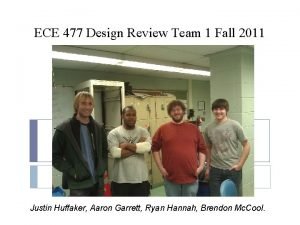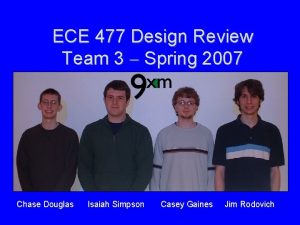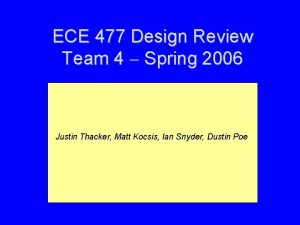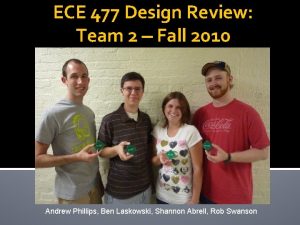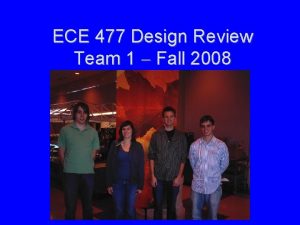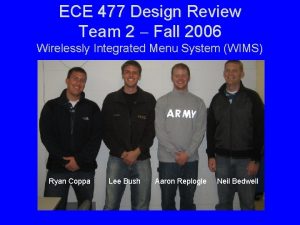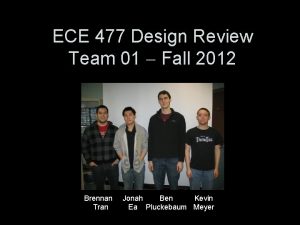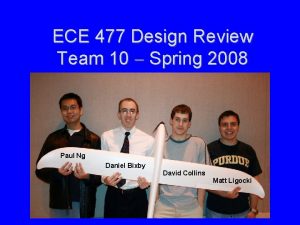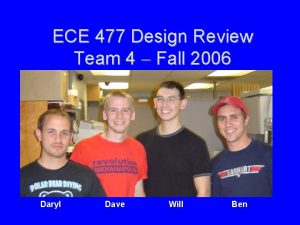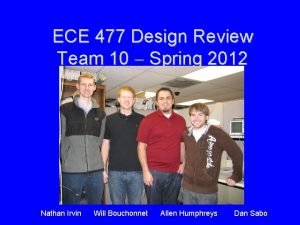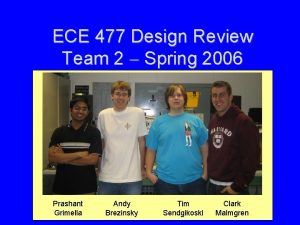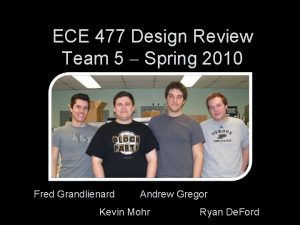ECE Grande ECE 477 Design Review Team 3





























- Slides: 29

ECE Grande ECE 477 Design Review Team 3 - Fall 2008

Introduction Ashley Pat Callaway Doherty n Pat Doherty n Nikeshia Ebron n Leo Romanovsky n Nikeshia Ebron Ashley Callaway Leo Romanovsky

Outline Project overview n Project-specific success criteria n Block diagram n Component selection rationale n Packaging design n Schematic and theory of operation n PCB layout n Software design/development status n Project completion timeline n Questions / discussion n

Project Overview n The ECE Grande is a digital poker game table. n All personal player information is digitally stored n The table will consist of 4 player stations n Central community screen to display community information n Web server to display the current game status on a remote computer

Project-Specific Success Criteria I. An ability to authenticate users using an RFID tag II. An ability to transmit/export the current game state via a TCP/IP connection III. An ability to display each player’s information on individual LCD screen and community information on a central screen.

PSSC – cont. IV. An ability to run a multi-player No. Limit Texas Hold’em game. V. An ability to interface with a distributed network of microcontrollers to control graphic LCDs and receive user input.

Block Diagram

Component Selection Rationale n Master Microcontroller : MC 9 S 12 NE 64 Embedded web server – TCP/IP protocol n 80 I/O pins n Alternative: PIC 18/Rabbit n n Slave Microcontroller : MC 9 S 12 GC Same manufacturer as master n 48 I/O pins n SPI port for communication with master n Alternative : PIC 18 n

Component Selection Rationale n RFID Reader An ability to turn antenna on and off n Alternative : Spark. Fun n n LCDs Cost n No negative voltages required for operation n Alternative : negative voltage Crystal. Fontz n

Package Design n Dimensions n n Material n n n 4 ft wide (front); 6. 5 ft wide (back); 2. 5 ft (angled side); 2. 16 ft deep; 4 in (height) 4 in X 3 in recessions for each player LCD covered by Lexan 41. 5 lbs 2 x 4 Pressure Treated Lumber ¼” Plywood Standard Green Poker Felt Lexan Constraints n Cost - $50. 00

Packaging Design

Packaging Design

Packaging Design

Schematic/Theory of Operation n Microcontroller n n n RFID n n n 5 V operation voltage 1 SCI Port and 1 GPIO Level Translator n n Master (25 MHz) Slave (16 MHz) Tx 0104 (3. 3 V – 5 V) Ethernet Transformer n RJ 45 connected directly to microcontroller

Schematic/Theory of Operation n LCD Crystal. Fontz CFAL 12864 L-Y-B 2 n 3. 3 V operation voltage n 90 m. A current draw n n Buttons Terminal Microswitch pushbuttons n Send signals to slave microcontroller n Will require 3 general I/O pins n

Schematic/Theory of Operation n Power Supply 9 V wall wart n Linear Regulators: (9 V to 5 V) and (9 V to 3. 3 V) n n Headers LCD n Push Buttons n Level Translators n

Schematic – Power and Control

Schematic – Master-Slave

Schematic - RFID

Schematic - Master

Schematic - Slave

PCB – Master Design n Bypass Capacitor Kept close to power sources n Located underneath Ethernet Adaptor n n Power n Divided by operating voltages (5 V right side – 3. 3 V left side)

PCB Layout - Master

PCB – Slave Design n Bypass Capacitor n n Kept close to power sources Headers n Placed around board edges for easy access

PCB Layout - Slave

Software Design/Development Status n RFID development n n Poker Logic Algorithm n n Drivers being written Assigns a numeric score to a given passed in poker hand Hand will consist of 7 cards (2 in hand, 5 community cards), score will be given based on best 5 card combination in hand. Winners are determined by comparing players hand score. LCD Interfacing

Part Status n Microcontroller (arrived) n LCD (arrived) n Ethernet Port (to be ordered) n Crystals (to be ordered) n Level Translator (arrived) n Development board (arrived) n RFID Reader & Tags (arrived)

Project Completion Timeline

Questions
 Ece477
Ece477 Ece 477
Ece 477 Ece 477
Ece 477 Ece 477
Ece 477 Siempre tenido un deseo
Siempre tenido un deseo Team spirit becomes team infatuation
Team spirit becomes team infatuation Team spirit becomes team infatuation
Team spirit becomes team infatuation The white team cheers for the blue team, just like
The white team cheers for the blue team, just like Sw 477
Sw 477 Diketahui log 2 = 0 301 maka log 50
Diketahui log 2 = 0 301 maka log 50 Sepura *477
Sepura *477 Biba n 477 ddl
Biba n 477 ddl Experiment 477
Experiment 477 Liedboek 477
Liedboek 477 Cse477
Cse477 Cs 477 uiuc
Cs 477 uiuc Opwekking 477
Opwekking 477 Jika log 2=0 301 dan log 3=0 477 maka nilai log 72 adalah
Jika log 2=0 301 dan log 3=0 477 maka nilai log 72 adalah 2 log 18
2 log 18 Vray roadmap
Vray roadmap Ceng 477
Ceng 477 Diketahui log 2 = 0 301 dan log 5 = 0 699
Diketahui log 2 = 0 301 dan log 5 = 0 699 Jika log 3=0 477 dan log 5=0 699 maka log 45 adalah
Jika log 3=0 477 dan log 5=0 699 maka log 45 adalah Red team proposal
Red team proposal Team review meeting
Team review meeting Chapter review motion part a vocabulary review answer key
Chapter review motion part a vocabulary review answer key Writ of certiorari ap gov example
Writ of certiorari ap gov example Narrative review vs systematic review
Narrative review vs systematic review What is inclusion and exclusion criteria
What is inclusion and exclusion criteria Narrative review vs systematic review
Narrative review vs systematic review

